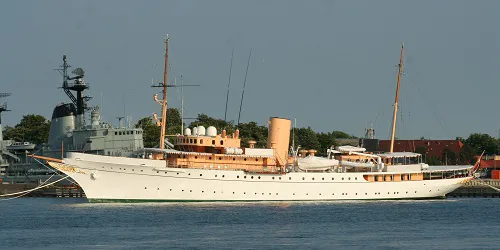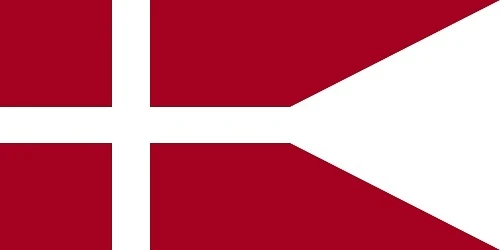-
Register Now for a Free Account!Unlock additional site access with your free account today, takes less than a minute, and guaranteed no spam - ever. Register Now!
Dannebrog #6 Oldest Active Military Ship - Cruising Earth

Dannebrog - Royal Danish Navy
#6 Oldest Active Military Ship
Dannebrog is currently ranked #6 in the list of the Oldest Active Military Ships.
Dannebrog Historical Brief
Introduction
The Royal Danish Navy ship Dannebrog, officially known as Her Danish Majesty's Yacht Dannebrog, is a historic and iconic vessel that has served as the royal yacht for Denmark since its launch in 1931. Named after the Danish national flag, the Dannebrog has played a significant role in Denmark's royal and maritime traditions, serving as both a royal residence and a symbol of Danish sovereignty and culture. This brief provides an overview of the ship's construction, historical significance, and ongoing role within the Royal Danish Navy.
Construction and Design (1931-1932)
The Dannebrog was built at the Danish naval shipyard in Copenhagen, under the supervision of Lieutenant Commander A.C. Jensen. The ship was designed by the naval architect F.C.H. Münter and was constructed to replace the previous royal yacht, which had been in service since 1879. Laid down in 1931, the Dannebrog was launched on October 10, 1931, and commissioned into service on May 26, 1932.
The Dannebrog is a motor yacht with a sleek, classic design that reflects the elegance and tradition of early 20th-century naval architecture. The ship measures 78.43 meters in length, with a beam of 10.40 meters and a draft of 3.62 meters. Its displacement is approximately 1,238 tons. The Dannebrog is powered by two B&W Alpha diesel engines, which provide a maximum speed of around 13.5 knots.
The yacht is divided into two main sections. The forward section is reserved for the crew, while the aft section houses the royal apartments, including living quarters, reception rooms, and offices for the royal family. The Dannebrog's interior is elegantly furnished, reflecting the ship's status as a floating royal residence.
Early Years and World War II (1932-1945)
Upon its commissioning, the Dannebrog quickly became an essential part of the Danish royal family's life. The ship was used for official state visits, royal tours, and various ceremonial functions. The Dannebrog's presence at international events and its role in diplomatic missions helped to promote Denmark's image abroad and strengthen its international relations.
During World War II, Denmark was occupied by Germany from April 1940 to May 1945. Throughout the occupation, the Dannebrog was laid up in the naval base at Holmen in Copenhagen and did not undertake any voyages. The ship remained under Danish control, and efforts were made to preserve it from potential damage or requisition by the occupying forces. The end of the war saw the Dannebrog return to its role as the royal yacht, resuming its duties and reestablishing its significance within the Danish monarchy.
Post-War Period and Modernization (1945-2000)
After World War II, the Dannebrog underwent several refits and upgrades to modernize its facilities and ensure its continued service. These upgrades included improvements to the ship's navigation and communication systems, as well as updates to its living quarters and onboard amenities. The yacht continued to be an essential tool for the Danish royal family, used for state visits, official tours, and summer cruises.
One of the most notable post-war events involving the Dannebrog was the 1953 state visit to the United States, marking the first time a reigning Danish monarch visited America. King Frederick IX and Queen Ingrid used the Dannebrog for part of their journey, underscoring the ship's role in promoting Danish diplomacy and international goodwill.
Throughout the latter half of the 20th century, the Dannebrog continued to serve as a symbol of Danish maritime heritage and royal tradition. The yacht's annual summer cruises around Denmark and the Faroe Islands became a cherished tradition, providing opportunities for the royal family to connect with Danish citizens and visit various parts of the kingdom.
Recent History and Ongoing Role (2000-Present)
In the 21st century, the Dannebrog remains an active and vital part of the Danish royal family's activities. The ship continues to undergo regular maintenance and periodic refits to ensure its operational readiness and preserve its historical character. These efforts have included significant overhauls to the ship's engines, hull, and onboard systems, ensuring that the Dannebrog remains seaworthy and capable of fulfilling its duties.
The Dannebrog's role in state visits and official tours continues to be of great importance. The yacht has been used to host foreign dignitaries, participate in international maritime events, and represent Denmark at significant global occasions. The ship's presence at these events underscores Denmark's commitment to maintaining its maritime traditions and fostering international relations.
One of the Dannebrog's most significant functions is its annual summer cruise, during which the royal family visits various parts of Denmark and its territories. These cruises provide a unique opportunity for the royal family to engage with citizens, support local communities, and promote cultural and historical awareness. The ship's visits to ports and coastal towns are often accompanied by public receptions, cultural events, and official ceremonies, highlighting the close connection between the monarchy and the Danish people.
Cultural and Symbolic Significance
The Dannebrog is not only a functional vessel but also a powerful symbol of Danish heritage and identity. The ship's name, derived from the Danish national flag, reflects its role as a representation of the nation's values and traditions. The Dannebrog's elegant design and historical significance have made it an enduring symbol of the Danish monarchy and its maritime legacy.
The yacht's involvement in state visits and international events also serves to strengthen Denmark's diplomatic ties and promote cultural exchange. The Dannebrog's voyages have taken it to numerous countries around the world, where it has been received with admiration and respect. These visits help to enhance Denmark's global standing and foster mutual understanding between nations.
Preservation and Future Prospects
As the Dannebrog approaches its centenary, efforts to preserve its historical integrity and operational capabilities continue. The ship undergoes regular maintenance and periodic refits to ensure it remains seaworthy and safe for royal duties. These efforts are crucial in preserving the ship's legacy for future generations and ensuring that it continues to serve as a symbol of Danish maritime tradition.
The future prospects for the Dannebrog are promising. The ship will continue to play a vital role in the activities of the Danish royal family, providing a platform for state visits, official tours, and ceremonial functions. Its role as a cultural and diplomatic ambassador will also endure, promoting Denmark's maritime heritage and fostering international understanding.
Conclusion
The Royal Danish Navy ship Dannebrog stands as a testament to Denmark's rich maritime history and its commitment to preserving and promoting its royal traditions. Over its nine decades of service, the ship has been a symbol of Danish sovereignty, a platform for diplomatic and cultural exchange, and a cherished part of the Danish royal family's life. As it continues to sail the world's oceans, the Dannebrog remains an enduring symbol of Denmark's maritime legacy and its dedication to the values of seamanship, tradition, and international friendship.


